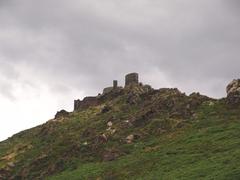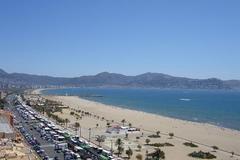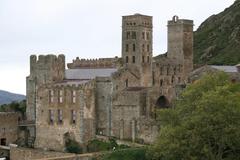Menhir de la Casa Cremada II: Complete Visitor Guide to Roses’ Megalithic Heritage
Date: 14/06/2025
Introduction
Set amidst the dramatic coastline and rolling hills of Roses in Catalonia, Spain, the Menhir de la Casa Cremada II stands as a remarkable relic of the region’s distant past. Dating from the late Neolithic to early Bronze Age (circa 4000–2500 BCE), this ancient standing stone is a key feature of one of the Iberian Peninsula’s most significant megalithic landscapes. Visitors are invited to explore not only the enigmatic menhir itself, but also a network of prehistoric monuments, breathtaking natural scenery, and vibrant cultural traditions that bring Roses’ ancient heritage to life (Visit Roses; Empordà Turisme).
This guide offers in-depth historical context, practical advice on visiting, and resources for making the most of your journey into Roses’ prehistoric past.
Table of Contents
- Historical and Archaeological Context
- Monument Types and Cultural Significance
- The Casa Cremada Megalithic Complex
- Physical Description and Conservation
- Visitor Information
- Visitor Experience and Practical Tips
- Cultural Events and Responsible Tourism
- Frequently Asked Questions (FAQ)
- Summary and Visitor Tips
- References and Further Reading
Historical and Archaeological Context
The megalithic monuments of Roses, including the Menhir de la Casa Cremada II, are among the oldest and most impressive in Catalonia. This region’s archaeological record traces back to the Upper Paleolithic, but its most visible legacy comes from the megalithic period (4000–2000 BCE), when early agricultural communities built monumental stone structures for funerary and ritual purposes (Visit Roses; Rosescultura.cat).
The Cap de Creus Natural Park, where the menhir is located, is rich with dolmens, menhirs, cists, and prehistoric carvings. These monuments, strategically situated along ridges and ancient pathways, reflect complex social, spiritual, and territorial dynamics.
Monument Types and Cultural Significance
Dolmens
Large stone tombs, or dolmens, are the most prominent megalithic features in Roses. The Dolmen de la Creu d’en Cobertella, for example, is the largest in Catalonia, with a chamber over 5 meters long and a capstone weighing more than 18 tons (Visit Roses). Dolmens served as communal burial sites and ritual centers.
Menhirs
Upright standing stones like the Menhir de la Casa Cremada II are believed to have marked territory, commemorated significant events, or served as ritual markers. Their placement and alignments sometimes suggest astronomical or landscape significance (Empordà Turisme).
Cists and Dolmen-Caves
Cists are small, stone burial boxes; dolmen-caves combine natural rock shelters with megalithic construction for funerary use (Visita Costa Brava).
Inscultures
Prehistoric carvings such as cup-marks and channels, found on exposed bedrock, hold unknown but likely ritual or symbolic significance (Rosescultura.cat).
The Casa Cremada Megalithic Complex
The Casa Cremada area is the heart of Roses’ megalithic heritage, located on the slopes above town. Key features include:
- Menhir de la Casa Cremada I: A 2.4-meter gneiss stele with a white quartz vein.
- Menhir de la Casa Cremada II: The focus of this guide, a triangular-sectioned gneiss stone, re-erected in 1999 (Visit Roses).
- Dolmen or Cist of Casa Cremada: Large burial stone with ancient retouched edges.
- Dry-Stone Huts and Terraces: Reflecting the continuity of stonework traditions.
The area’s integration of prehistoric, medieval, and modern features demonstrates continuous human presence and spiritual continuity (Femturisme).
Physical Description and Conservation
Menhir de la Casa Cremada II is a standing gneiss stone, about 2.35 meters high, with a distinct triangular cross-section. Discovered broken in 1998, it was re-erected during the “Maig Megalític” festival in 1999, though its original placement hole remains unknown. A low masonry enclosure supports the stone and protects it from further damage, following recent vandalism (Visit Roses; Sortir amb Nens).
The site is surrounded by agricultural terraces and dry-stone walls, recognized as part of Catalonia’s intangible heritage. Conservation is ongoing, balancing access with preservation (Femturisme).
Visitor Information
Location and Access
Menhir de la Casa Cremada II is accessible via the Ruta Megalítica de Roses, a marked trail beginning near Roses town. The main trailhead is reachable by a short drive from the town center, with limited parking available (Visita Costa Brava). Public transport options are limited; private vehicles or taxis are recommended.
Visiting Hours and Tickets
- Hours: Open year-round, 24/7 as an outdoor site. Visit during daylight for safety and optimal viewing.
- Tickets: Entry is free; no reservation required (Visit Roses Official).
Accessibility
The approach involves a moderate hike over uneven and rocky terrain; not suitable for wheelchairs or strollers. Children accustomed to hiking can manage the route with supervision.
Facilities
There are no restrooms or refreshments at the site; amenities are available in Roses. The tourist office provides maps and brochures (Visit Roses).
Visitor Experience and Practical Tips
When to Visit
- Season: Spring and autumn offer mild weather and scenic wildflowers. Summer can be hot and dry; winter is windy but mild.
- Time of Day: Early morning or late afternoon for best light and cooler temperatures.
What to Bring
- Sturdy shoes or hiking boots
- Water and snacks
- Sun protection (hat, sunscreen, sunglasses)
- Camera or smartphone
Etiquette and Safety
- Do not climb or touch the menhir or enclosure.
- Take litter with you.
- Maintain quiet to appreciate the historic setting.
- Check the weather, as the area is exposed to strong winds.
- Use a map or GPS for navigation on the trails (Wikiloc).
Integration with the Megalithic Route
Consider exploring the full Ruta Megalítica de Roses, which includes additional dolmens, menhirs, and dry-stone features (Visita Costa Brava). Guided tours and educational panels enhance the experience, especially during the annual “Maig Megalític” festival.
Cultural Events and Responsible Tourism
The “Maig Megalític” festival in May celebrates Roses’ prehistoric heritage with guided walks, lectures, and community gatherings. The festival played a pivotal role in the re-erection and ongoing preservation of Menhir de la Casa Cremada II (Femturisme). Visitors are encouraged to respect the site and support local conservation efforts.
Frequently Asked Questions (FAQ)
Q: Is entry to Menhir de la Casa Cremada II free?
A: Yes, the site is free to visit.
Q: What are the visiting hours?
A: The site is open year-round, but daylight visits are recommended for safety.
Q: Are guided tours available?
A: Yes, particularly during the “Maig Megalític” festival in May. Check with the Roses Tourist Office for schedules.
Q: Is the site wheelchair accessible?
A: No, due to rocky and uneven trails.
Q: Where can I park?
A: Limited parking is available at the trailhead; arrive early to secure a spot.
Summary and Visitor Tips
Menhir de la Casa Cremada II is more than an ancient monument—it is a gateway to understanding Catalonia’s deep-rooted past. Its enduring presence, alongside the surrounding megalithic features and dry-stone works, showcases the region’s long history of human settlement and spiritual expression. Open year-round and free to visit, the menhir is accessible via scenic hiking trails that offer both natural beauty and archaeological intrigue.
References and Further Reading
- Visit Roses – Menhir de la Casa Cremada II
- Femturisme – Megalithic and Dry Stone Itinerary
- Visita Costa Brava – Ruta Megalítica de Roses
- Empordà Turisme – Menhir de la Casa Cremada
- Sortir amb Nens – Itineraris Megalítics
- Mapcarta – Menhir de Casa Cremada II
For more information, maps, and the latest updates on festivals and guided tours, visit the official Roses Tourism website.



